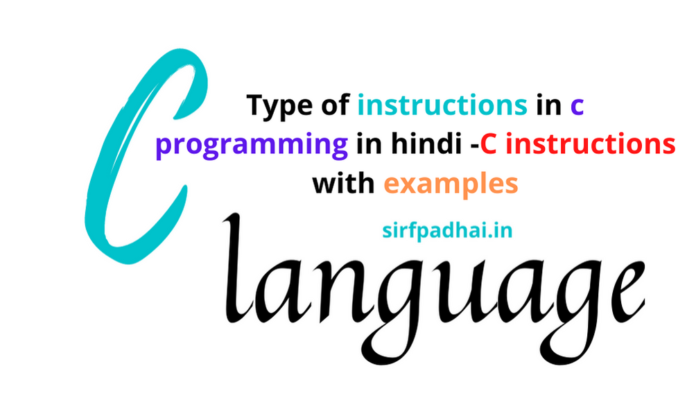मुझे उम्मीद है, कि इस ट्यूटोरियल को जारी रखने से पहले आपने मूल printf() और scanf() प्रोग्राम लिखे होंगे। यदि आपने नहीं किया तो मैं आपको इसे करने की दृढ़ता से अनुशंसा करता हूं। यहां से पिछले ट्यूटोरियल पढ़ें। वैसे भी अब तक हमने C के बहुत ही बेसिक प्रोग्राम्स को कवर किया है। हमने इसमें बहुत से निर्देशों का इस्तेमाल किया है। तो आज मैं आपको C के निर्देशों (instruction) के बारे में बताऊंगा|
Type of instructions in c programming in Hindi
Types of Instructions in C: C Language में किसी Program File में हम मुख्यतया तीन तरह के Instructions लिखते हैं। इन तीनों प्रकार के Instructions का एक विशेष काम होता है और हर प्रकार Instruction अपने उस विशेष काम को पूरा करता है। ये तीनों Instructions निम्नानुसार होते हैं:
| There are basically three types of C instructions. |
| 1. Type Declaration Instruction |
| 2. Arithmetic Instruction |
| 3. Control Instruction |
1.Type Declaration Instruction:
ये वे Instructions होते जिनका प्रयोग करके, हम विभिन्न प्रकार के Data को Computer की Memory में Store करने के लिए, Memory Reserve करते हैं। हम जिस किसी भी Data को Program में Process करना चाहते हैं| उस Data को Store करने के लिए हमें Memory की जरूरत होती है|
जहां उन Process किए जाने वाले Data को Hold करके रखना होता है। Required Data के आधार पर हमें Memory में कुछ जगह Reserve करने के लिए जिन Instructions का प्रयोग करना होता है|
उन्हें Type Declaration Instructions कहते हैं। इन Instructions का प्रयोग करके हम विभिन्न प्रकार के Variables Declare करते हैं।
जैसा कि इसके नाम से पता चलता है| कि इसका उपयोग C भाषा में वेरिएबल के प्रकार घोषित करने के लिए किया जाता है। यह आवश्यक है| कि उपयोग करने से पहले आपको चर के प्रकार को घोषित करना होगा। और यह भी आवश्यक है कि इस प्रकार के घोषणा निर्देश कार्यक्रम की शुरुआत में (Main() के ठीक बाद) प्रदान किए जाने चाहिए।
आइए अब उनमें कुछ भिन्नताओं के बारे में जानें।
A) हम इसकी घोषणा के समय वैरिएबल को ( initialize ) इनिशियलाइज़ कर सकते हैं।
Example
int a=3;
char a=’d’;
int a=7*3*2;B) चरों की घोषणा करते समय उनका क्रम याद रखें।
Example
int i=3,j=5; is same as int j=5,i=3;हालाँकि, (However)
float a=5.5,b=a+7.1; is alright, but
float b=a+7.1,a=5.5; is not valid ऐसा इसलिए है क्योंकि उपरोक्त घोषणा में हम इसे परिभाषित करने से पहले ही Char का उपयोग करने का प्रयास कर रहे हैं।
C) Char घोषित करते समय एक और interesting point है|
नीचे गए instruction काम करेगा |
int a,b,c,d;
a=b=c=10; हालांकि, निम्नलिखित statement काम नहीं करेगा।
int a=b=c=d=10 ;अब हम फिर से variables को परिभाषित करने से पहले ही उपयोग करने का प्रयास कर रहे हैं।
मुझे उम्मीद है| कि अब आप type declaration instruction के महत्व को समझ गए होंगे। इसलिए हम variable को परिभाषित करने के बाद ही उपयोग कर सकते हैं। और इन परिभाषाओं को Main () body की शुरुआत में लिखा जाना चाहिए। हम प्रोग्राम में कहीं और variable को परिभाषित नहीं कर सकते हैं। यदि आप ऐसा करते हैं, तो आपको प्रोग्राम में error आएगा|
2. Arithmetic Instruction :
एक Arithmetical Instruction में हमेंशा एक Assignment Operator का प्रयोग करके किसी Calculation से प्राप्त परिणाम को किसी Variable में Store करना होता है। Assignment Operator के Left Side में हमेंशा एक Variable ही हो सकता है| जबकि इसके Right Side में Calculation में भाग लेने वाले Variable व Constants का पूरा एक समूह हो सकता है। किसी Assignment Operator के Left Side में हम कभी भी किसी Constant Identifier को Place नहीं कर सकते हैं। यदि हम ऐसा करते हैं, तो Compiler हमें “Lvalue Required” नाम का एक Error प्रदान करता है। यानी
int x, y = 10;
x = y + 2;यदि हम उपरोक्त Instruction लिखते हैं, तो Program में किसी तरह का कोई Error Generate नहीं होगा और y + 2 Expression से Generate होने वाला Resultant मान 12 Variable x में Store हो जाएगा। लेकिन यदि हम इसी Instruction के मानों की Position को निम्नानुसार Exchange कर दें, तो हमें “Lvalue Required” का Error Message प्राप्त होता हैः
int x, y = 10;
y + 2 = x; // Error: Lvalue requiredGeneral form of an arithmetic instruction follow rules given below.
i) It should contain one assignment operator i.e. =.
ii) On the left side of =, there should be one variable.
iii) On the right side of =, there should be variables and constants.
iv) And those variables and constants will be connected by some arithmetic operators like +,-,*,/,%.
Example
int a=12;
float b,c=2.2;
b=c+a/6.1*8; Operands क्या होते हैं?
ये variable और स्थिरांक एक साथ ऑपरेंड कहलाते हैं। ये operands arithmetic operators द्वारा जुड़े हुए हैं।
arithmetic instructions का निष्पादन कैसे होता है?
सबसे पहले assignment operator (=) के right ओर सभी variable और स्थिरांक की calculated किया जाता है। उसके बाद परिणाम assignment operator के left ओर variable में संग्रहीत किया जाता है |
आइए अब arithmetic operators की कुछ बारीकियों की जाँच करें |
1. Left side = के केवल एक variable का उपयोग करना अनिवार्य है।
Example
c=a*b is correct,
whereas a*b=c is incorrect.2. C में modular operator (%) नाम के ऑपरेटर का भी उपयोग किया जाता है। यह modular operator शेष को assignment operator के left side के variable में वापस कर देगा। इसका उपयोग floats के साथ नहीं किया जा सकता है। यह वही चिन्ह लौटाएगा जो अंश (num) के पास है।
Example
-5%2=-1
-5 %-2=1
3. Control Instruction:
तीसरे प्रकार के Instructions को Control Instructions कहा जाता है। ये Instructions Computer को विभिन्न प्रकार के काम करने के लिए तथा Program के Flow को मनचाही दिशा देने के लिए Use किए जाते हैं। विभिन्न प्रकार के Decision Making Instructions द्वारा हम Computer को विभिन्न प्रकार के Decision लेने की क्षमता प्रदान करते हैं, तथा Iterative Instructions का प्रयोग करके हम Computer को Repetitive या बार-बार दोहराए जाने वाले कामों को करने के लिए Instructions देते हैं। Control Instructions मुख्यतया चार प्रकार के होते हैं, जो अग्रानुसार है:
*Sequence Control Instructions
*Selection or Decision Control Instructions
*Repetition or Loop Control Instructions
*Case Controls InstructionsControl Statements अपने आप में काफी महत्वपूर्ण Statement होते हैं| क्योंकि पूरे Program के Flow को Control Flow Statements द्वारा ही Control किया जाता है। उदाहरण के लिए जब हमें किसी Statement को बार-बार Execute करना होता है, तब हमें Looping Statement की जरूरत होती है,|
जो कि एक Control Statement है| और इसके अन्तर्गत for, while, do…while जैसे Statements आते हैं। इसी तरह से जब हमें किसी Specific Condition के आधार पर किसी Particular Statement या Statement Block को Execute करना होता है| तब हमें Decision Making Statements की जरूरत होती है| जिसके अन्तर्गत if, if…else, elseif, switch, goto जैसे Statements आते हैं।
इसलिए एक अच्छा प्रोग्रामर बनने के लिए| तीसरे टाइप का स्टेटमेंट को अच्छी तरह से पढ़ना जरूरी है| और आपके लिए c language से related Full कोर्स available है | आप टॉपिक wise पढ़े जिससे आपको समझने में आसानी होगी| पोस्ट पसंद आए तो हमे फॉलो जरूर करे| हम आने वाले समय में कोडिंग लैंग्वेजेस से related in future जरूर लाने वाले हैं |
Thank you आपका दिन मंगलमय हो
पढ़ते रहिए और बढ़ते रहिए | Keep Reading and Keep Growing









[…] Type of instructions in c programming in hindi -C instructions with… […]